
A meterstick is mounted horizontally above a turntable as shown. Identical metal washers are hung at the positions shown. The turntable and meterstick are then spun. Rank from greatest to least, the following quantities for the washers.
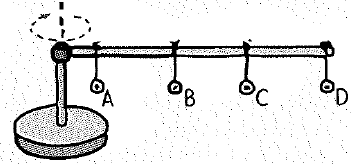
a. rotational speed
b. linear speed
c. angle the string makes with the vertical
d. inward force on each
e. outward force on each
(a)
To rank: The washer on the basis of rotational speed from greatest to least.
Answer to Problem 20A
The rank of the rotational speed from greatest to least is
Explanation of Solution
Introduction:
Rotational speed is the number of rotations per unit time and is also known as angular velocity. It is represented as
The given figure is shown below.
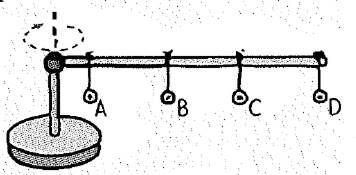
Identical metal washers are hung at the positions on a meterstick is mounted horizontally above a turntable.
The rotation of turn table rotates the metal washers in the meterstick at the same speed. Hence, the rotational speeds of the metal washers are same.
Conclusion:
Thus, the rank of the rotational speed from greatest to least is
(b)
To rank: The washer on the basis of the linear speed from greatest to least.
Answer to Problem 20A
The rank of the linear speed from greatest to least is
Explanation of Solution
Introduction:
The expression for the linear or tangential speed is,
Here,
Tangential speed is dependent on the distance from the axis of rotation and rotational speed.
The given figure is shown below.
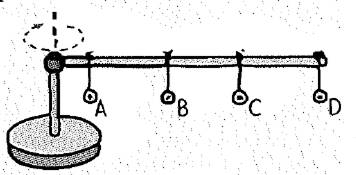
The linear speed and the radius of its circular path’ radius are directly proportional to each other.
The radius of the metal washer D is more when compared to the other washers.
The radius of the metal washer A is less when compared to the other washers.
So, the metal washer D’s linear speed is greater than the linear speed of the other washers.
Conclusion:
Thus, the rank of the linear speed from greatest to least is
(c)
To rank: The washer on the basis of angle that string makes with the vertical from greatest to least.
Answer to Problem 20A
The rank of the angle the string makes with the vertical from greatest to least is
Explanation of Solution
Introduction:
The force exerted on the system is directly proportional to the square of the tangential speed.
Linear speed varies with the distance from the axis of rotation.
The expression for the linear or tangential speed is,
Here,
The given figure is shown below.
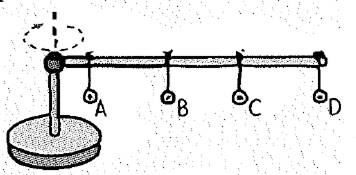
The linear speed is directly proportional to the radius of its circular path.
From part (b), the rank of the linear speed from greatest to least is
The radius of the metal washer D is more when compared to the other washers.
The radius of the metal washer A is less when compared to the other washers.
By comparing the values of the angle the string makes with the vertical is
Conclusion:
Thus, the rank of the angle the string makes with the vertical from greatest to least is
(d)
To rank: The washer on the basis of the inward force on each from greatest to least.
Answer to Problem 20A
The rank of the inward force on each from greatest to least is
Explanation of Solution
Introduction:
The expression for the centripetal force is,
Here,
The expression for the linear or tangential speed is,
Here,
The given figure is shown below.
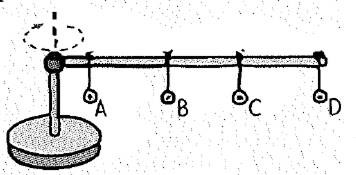 From part (b), the rank of the linear speed from greatest to least is
From part (b), the rank of the linear speed from greatest to least is
The centripetal force or inward force is directly proportional to the square of the linear speed.
By comparing the values of the linear speed, the centripetal force is
Conclusion:
Thus, the rank of the inward force on each from greatest to least is
(e)
To rank: The washers on the basis of outward force from greatest to least.
Answer to Problem 20A
The outward force is not there for the system.
Explanation of Solution
Introduction:
The expression for the centripetal force is,
Here,
The expression for the linear or tangential speed is,
Here,
The given figure is shown below.
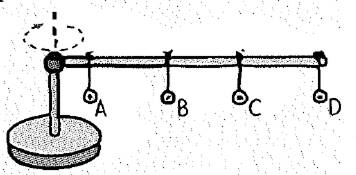
The centripetal force is the inward force and it is directly proportional to the square of the linear speed.
In the meterstick and turntable, there is only the centripetal or inward force act on the system.
So there is outward force doesn’t act on the system.
Conclusion:
Thus, outward force is not there for the system.
Chapter 10 Solutions
Conceptual Physics C2009 Guided Reading & Study Workbook Se
Additional Science Textbook Solutions
College Physics: A Strategic Approach (3rd Edition)
Cosmic Perspective Fundamentals
Microbiology: An Introduction
Chemistry: A Molecular Approach (4th Edition)
Campbell Essential Biology (7th Edition)
Human Anatomy & Physiology (2nd Edition)
- What can be said about the electric force between two charged particles? It varies as 1/r. It depends only on the magnitudes of the charges. It is much, much greater than the attractive gravitational force. It is repulsive for unlike charges.arrow_forwardA piece of copper originally 305mm long is pulled in tension with a stress of 276MPa. If the deformation is elastic, what will be the resultant elongation. E for copper is 110Gpaarrow_forwardPlease solve and answer the problem correctly please. Be sure to give explanations on each step and write neatly please. Thank you!!arrow_forward
- In the figures, the masses are hung from an elevator ceiling. Assume the velocity of the elevator is constant. Find the tensions in the ropes (in N) for each case. Note that 0₁ = 35.0°, 0₂ = 55.0°, 03 = 60.0°, m₁ = 3.00 kg, and m2 = 7.00 kg. (Due to the nature of this problem, do not use rounded intermediate values-including answers submitted in WebAssign-in your calculations.) (a) Τι WY NY MY T3 e₁ T₁ = N = N = N (b) 18 Τι = Τι T3 = || || || = T T Ts m₂ N N N 02 T₂ T3 m₁arrow_forwardYou are working with a movie director and investigating a scene with a cowboy sliding off a tree limb and falling onto the saddle of a moving horse. The distance of the fall is several meters, and the calculation shows a high probability of injury to the cowboy from the stunt. Let's look at a simpler situation. Suppose the director asks you to have the cowboy step off a platform 2.55 m off the ground and land on his feet on the ground. The cowboy keeps his legs straight as he falls, but then bends at the knees as soon as he touches the ground. This allows the center of mass of his body to move through a distance of 0.660 m before his body comes to rest. (Center of mass will be formally defined in Linear Momentum and Collisions.) You assume this motion to be under constant acceleration of the center of mass of his body. To assess the degree of danger to the cowboy in this stunt, you wish to calculate the average force upward on his body from the ground, as a multiple of the cowboy's…arrow_forwardA box of mass m = 2.00 kg is released from rest at the top of an inclined plane as seen in the figure. The box starts out at height h =0.200 m above the top of the table, the table height is H = 2.00 m, and 0 = 41.0°. H m (a) What is the acceleration (in m/s²) of the box while it slides down the incline? m/s² (b) What is the speed (in m/s) of the box when it leaves the incline? m/s (c) At what horizontal distance (in m) from the end of the table will the box hit the ground? m (d) How long (in s) from when the box is released does it hit the ground? S (e) Does the box's mass affect any of your above answers? Yes Noarrow_forward
- (a) A sphere made of rubber has a density of 0.940 g/cm³ and a radius of 7.00 cm. It falls through air of density 1.20 kg/m³ and has a drag coefficient of 0.500. What is its terminal speed (in m/s)? m/s (b) From what height (in m) would the sphere have to be dropped to reach this speed if it fell without air resistance? marrow_forwardThe systems shown below are in equilibrium. If the spring scales are calibrated in newtons, what do they read? Ignore the masses of the pulleys and strings and assume the pulleys and the incline are frictionless. (Let m = 2.19 kg and € = 29.0°.) scale in (a) N N scale in (b) scale in (c) N scale in (d) N a C m m m m m b d m Ꮎarrow_forwardAn elevator car has two equal masses attached to the ceiling as shown. (Assume m = 3.10 kg.) m m T₁ T2 (a) The elevator ascends with an acceleration of magnitude 2.00 m/s². What are the tensions in the two strings? (Enter your answers in N.) = N T₁ Τι = N (b) The maximum tension the strings can withstand is 78.8 N. What is the maximum acceleration of the elevator so that a string does not break? (Enter the magnitude in m/s².) m/s²arrow_forward
- (a) At what speed (in m/s) will a proton move in a circular path of the same radius as an electron that travels at 7.85 x 100 m/s perpendicular to the Earth's magnetic field at an altitude where the field strength is 1.20 x 10-5 T? 4.27e3 m/s (b) What would the radius (in m) of the path be if the proton had the same speed as the electron? 7.85e6 x m (c) What would the radius (in m) be if the proton had the same kinetic energy as the electron? 195.38 x m (d) What would the radius (in m) be if the proton had the same momentum as the electron? 3.7205 marrow_forward! Required information The block shown is made of a magnesium alloy, for which E = 45 GPa and v = 0.35. Know that σx = -185 MPa. NOTE: This is a multi-part question. Once an answer is submitted, you will be unable to return to this part. 25 mm B D 40 mm 100 mm Determine the magnitude of Oy for which the change in the height of the block will be zero. The magnitude of Oy is MPa.arrow_forwardThe rigid bar ABC is supported by two links, AD and BE, of uniform 37.5 × 6-mm rectangular cross section and made of a mild steel that is assumed to be elastoplastic with E = 200 GPa and σy= 250 MPa. The magnitude of the force Q applied at B is gradually increased from zero to 265 kN and a = 0.640 m. 1.7 m 1 m D A B 2.64 m E Determine the value of the normal stress in each link. The value of the normal stress in link AD is The value of the normal stress in link BE is 250 MPa. MPa.arrow_forward
 College PhysicsPhysicsISBN:9781305952300Author:Raymond A. Serway, Chris VuillePublisher:Cengage Learning
College PhysicsPhysicsISBN:9781305952300Author:Raymond A. Serway, Chris VuillePublisher:Cengage Learning University Physics (14th Edition)PhysicsISBN:9780133969290Author:Hugh D. Young, Roger A. FreedmanPublisher:PEARSON
University Physics (14th Edition)PhysicsISBN:9780133969290Author:Hugh D. Young, Roger A. FreedmanPublisher:PEARSON Introduction To Quantum MechanicsPhysicsISBN:9781107189638Author:Griffiths, David J., Schroeter, Darrell F.Publisher:Cambridge University Press
Introduction To Quantum MechanicsPhysicsISBN:9781107189638Author:Griffiths, David J., Schroeter, Darrell F.Publisher:Cambridge University Press Physics for Scientists and EngineersPhysicsISBN:9781337553278Author:Raymond A. Serway, John W. JewettPublisher:Cengage Learning
Physics for Scientists and EngineersPhysicsISBN:9781337553278Author:Raymond A. Serway, John W. JewettPublisher:Cengage Learning Lecture- Tutorials for Introductory AstronomyPhysicsISBN:9780321820464Author:Edward E. Prather, Tim P. Slater, Jeff P. Adams, Gina BrissendenPublisher:Addison-Wesley
Lecture- Tutorials for Introductory AstronomyPhysicsISBN:9780321820464Author:Edward E. Prather, Tim P. Slater, Jeff P. Adams, Gina BrissendenPublisher:Addison-Wesley College Physics: A Strategic Approach (4th Editio...PhysicsISBN:9780134609034Author:Randall D. Knight (Professor Emeritus), Brian Jones, Stuart FieldPublisher:PEARSON
College Physics: A Strategic Approach (4th Editio...PhysicsISBN:9780134609034Author:Randall D. Knight (Professor Emeritus), Brian Jones, Stuart FieldPublisher:PEARSON





